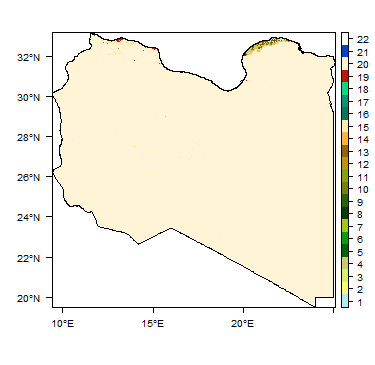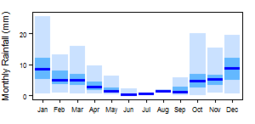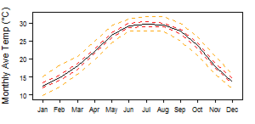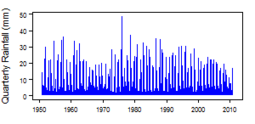Hydrogeology of Libya: Difference between revisions
m Protected "Hydrogeology of Libya" ([Edit=Allow only administrators] (indefinite) [Move=Allow only administrators] (indefinite)) [cascading] |
No edit summary |
||
| Line 1: | Line 1: | ||
[[Africa Groundwater Atlas Home | Africa Groundwater Atlas]] >> [[Hydrogeology by country | Hydrogeology by country]] >> Hydrogeology of Libya | |||
'''If you have more recent information on the hydrogeology of Libya, please get in touch.''' | |||
== | ==Compilers== | ||
'''Dr Kirsty Upton''' and '''Brighid Ó Dochartaigh''', British Geological Survey, UK | |||
==[[ | ==Geographical Setting== | ||
[[File:Libya_Political.png | right | frame | Map of Libya (For more information on the datasets used in the map see the [[Geography | geography resources section]])]] | |||
===General=== | |||
{| class = "wikitable" | |||
|- | |||
|Estimated Population in 2013* || 6,201,521 | |||
|- | |||
|Rural Population (% of total) (2013)* || 21.8% | |||
|- | |||
|Total Surface Area* || 1,759,540 sq km | |||
|- | |||
|Agricultural Land (% of total area) (2012)* || 8.7% | |||
|- | |||
|Capital City || Tripoli | |||
|- | |||
|Region || Northern Africa | |||
|- | |||
|Border Countries || Egypt, Sudan, Chad, Niger, Algeria, Tunisia | |||
|- | |||
|Annual Freshwater Withdrawal (2013)* || 4,326 Million cubic metres | |||
|- | |||
|Annual Freshwater Withdrawal for Agriculture (2013)* || 82.9% | |||
|- | |||
|Annual Freshwater Withdrawal for Domestic Use (2013)* || 14.1% | |||
|- | |||
|Annual Freshwater Withdrawal for Industry (2013)* || 3.1% | |||
|- | |||
|Rural Population with Access to Improved Water Source (2012)* || n/a | |||
|- | |||
|Urban Population with Access to Improved Water Source (2012)* || n/a | |||
|} | |||
<nowiki>*</nowiki> Source: World Bank | |||
===Climate=== | |||
<gallery widths="375px" heights=365px mode=nolines> | |||
File:Libya_ClimateZones.png |Koppen Geiger Climate Zones | |||
File:Libya_ClimatePrecip.png |Average Annual Precipitation | |||
File:Libya_ClimateTemp.png |Average Temperature | |||
</gallery> | |||
[[File:Libya_pre_Monthly.png| 255x124px| Average monthly precipitation for Libya showing minimum and maximum (light blue), 25th and 75th percentile (blue), and median (dark blue) rainfall]] [[File:Libya_tmp_Monthly.png| 255x124px| Average monthly temperature for Libya showing minimum and maximum (orange), 25th and 75th percentile (red), and median (black) temperature]] [[File:Libya_pre_Qts.png | 255x124px | Quarterly precipitation over the period 1950-2012]] [[File:Libya_pre_Mts.png|255x124px | Monthly precipitation (blue) over the period 2000-2012 compared with the long term monthly average (red)]] | |||
For further detail on the climate datasets used see the [[Climate | climate resources section]]. | |||
===Surface water=== | |||
{| | |||
|- | |||
| | |||
| [[File:Libya_Hydrology.png | frame | Surface Water Map of Libya (For more information on the datasets used in the map see the [[Surface water | surface water resources section]])]] | |||
|} | |||
===Soil=== | |||
{| | |||
|- | |||
| [[File:Libya_soil.png | frame | Soil Map of Libya (For map key and more information on the datasets used in the map see the [[Soil | soil resources section]])]] | |||
| | |||
|} | |||
===Land cover=== | |||
{| | |||
|- | |||
| | |||
| [[File:Libya_LandCover.png | frame | Land Cover Map of Libya (For map key and more information on the datasets used in the map see the [[Land cover | land cover resources section]])]] | |||
|} | |||
==Geology== | |||
The geology map shows a simplified version of the geology at a national scale. More information is available in the report [http://www.bgs.ac.uk/africagroundwateratlas/fulldetails.cfm?id=AGLA060041 UN (1988)] (see References section, below). | |||
{| | |||
|- | |||
| | |||
| [[File:Libya_Geology.png | frame | Simplified Geology of Libya (For more information on the datasets used in the map see the [[Geology | the Geology resources page]])]] | |||
|} | |||
==Hydrogeology== | ==Hydrogeology== | ||
The hydrogeology map below shows a simplified version of the type and productivity of the main aquifers at a national scale (see [[Aquifer properties| the Aquifer properties resource page]] for more details). | |||
More information on the hydrogeology of Libya is available in the report [http://www.bgs.ac.uk/africagroundwateratlas/fulldetails.cfm?id=AGLA060041 UN (1988)] (see References section, below). | |||
[[File:Libya_Hydrogeology.png]] [[File: Hydrogeology_Key.png | 500x195px]] | |||
=== Transboundary aquifers=== | |||
For further information about transboundary aquifers, please see the [[Transboundary aquifers | Transboundary aquifers resources page]]. | |||
==References== | |||
=== | References with more information on the geology and hydrogeology of Libya can be accessed through the [http://www.bgs.ac.uk/africagroundwateratlas/searchResults.cfm?title_search=&author_search=&category_search=&country_search=LY&placeboolean=AND&singlecountry=1 Africa Groundwater Literature Archive]. | ||
= | United Nations. 1988. [http://www.bgs.ac.uk/africagroundwateratlas/fulldetails.cfm?id=AGLA060041 Groundwater in North and West Africa: Libya]. United Nations Department of Technical Cooperation for Development and Economic Commission for Africa. | ||
===[[Groundwater | ==Return to the index pages== | ||
[[Africa Groundwater Atlas Home | Africa Groundwater Atlas]] >> [[Hydrogeology by country | Hydrogeology by country]] >> Hydrogeology of Libya | |||
Revision as of 14:27, 22 September 2015
Africa Groundwater Atlas >> Hydrogeology by country >> Hydrogeology of Libya
If you have more recent information on the hydrogeology of Libya, please get in touch.
Compilers
Dr Kirsty Upton and Brighid Ó Dochartaigh, British Geological Survey, UK
Geographical Setting

General
| Estimated Population in 2013* | 6,201,521 |
| Rural Population (% of total) (2013)* | 21.8% |
| Total Surface Area* | 1,759,540 sq km |
| Agricultural Land (% of total area) (2012)* | 8.7% |
| Capital City | Tripoli |
| Region | Northern Africa |
| Border Countries | Egypt, Sudan, Chad, Niger, Algeria, Tunisia |
| Annual Freshwater Withdrawal (2013)* | 4,326 Million cubic metres |
| Annual Freshwater Withdrawal for Agriculture (2013)* | 82.9% |
| Annual Freshwater Withdrawal for Domestic Use (2013)* | 14.1% |
| Annual Freshwater Withdrawal for Industry (2013)* | 3.1% |
| Rural Population with Access to Improved Water Source (2012)* | n/a |
| Urban Population with Access to Improved Water Source (2012)* | n/a |
* Source: World Bank
Climate
-
Koppen Geiger Climate Zones
-
Average Annual Precipitation
-
Average Temperature
For further detail on the climate datasets used see the climate resources section.
Surface water
|
|
 |
Soil
 |
Land cover
 |
Geology
The geology map shows a simplified version of the geology at a national scale. More information is available in the report UN (1988) (see References section, below).
|
|
 |
Hydrogeology
The hydrogeology map below shows a simplified version of the type and productivity of the main aquifers at a national scale (see the Aquifer properties resource page for more details).
More information on the hydrogeology of Libya is available in the report UN (1988) (see References section, below).
Transboundary aquifers
For further information about transboundary aquifers, please see the Transboundary aquifers resources page.
References
References with more information on the geology and hydrogeology of Libya can be accessed through the Africa Groundwater Literature Archive.
United Nations. 1988. Groundwater in North and West Africa: Libya. United Nations Department of Technical Cooperation for Development and Economic Commission for Africa.
Return to the index pages
Africa Groundwater Atlas >> Hydrogeology by country >> Hydrogeology of Libya








